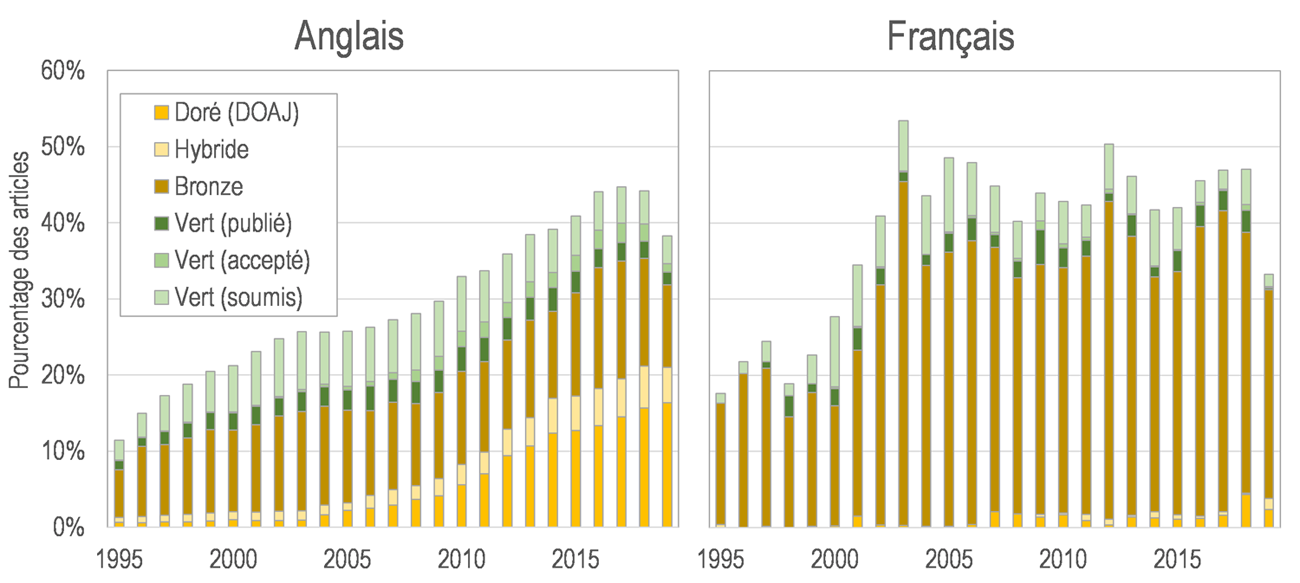To mark International Open Access Week, we’re pleased to share key findings from a recent study on open access in Canada. The study was conducted by Érudit’s Scientific Director Vincent Larivière, who is also a professor at the University of Montreal and the Canada Research Chair in the Transformations of Scholarly Communication, and Virginie Paquet, Master’s student in Information Science at École de bibliothéconomie et des sciences de l’information, Université de Montréal.
In April 2020, they analyzed the Dimensions.ai database and discovered three major trends in open access in Canada from 2015 to 2019:
1. Differences between languages
 Figure 1. Percentage of Canadian articles that are open access, by type and language, 1995 to 2019.
Figure 1. Percentage of Canadian articles that are open access, by type and language, 1995 to 2019.
Articles written in French are published under an open access model more often than those in English. Most of these articles are available on erudit.org platform. The platform’s publication policy is aligned with the Tri-Agency Open Access Policy on Publications.
However, the percentage of French-language articles that are open access has remained relatively stable since the early 2000s, while the proportion of English-language articles that are open access has been steadily increasing.
2. Major differences between institutions
 Figure 2. Percentage of open access articles, by type, for Canadian institutions with more than 2,000 articles, 2015 to 2019.
Figure 2. Percentage of open access articles, by type, for Canadian institutions with more than 2,000 articles, 2015 to 2019.
Researchers at Quebec universities (led by the University of Montreal, Laval University, McGill University and the University of Sherbrooke) have published a higher percentage of open access papers than the national average.
Meanwhile, the most prolific institutions in natural sciences and engineering (Waterloo, Concordia, Polytechnique and Ryerson) have a much higher percentage of green open access papers.
3. Major differences between disciplines
 Figure 3. Percentage of open access articles, by type, for Canada’s leading granting agencies, 2015 to 2019 (left); for Canada’s top three federal granting agencies, 2005 to 2019 (right).
Figure 3. Percentage of open access articles, by type, for Canada’s leading granting agencies, 2015 to 2019 (left); for Canada’s top three federal granting agencies, 2005 to 2019 (right).
More than 60% of articles funded by health-sector granting agencies (Public Health Canada, Genome Canada, Michael Smith Foundation, CIHR and FRQS) were immediately available for open access. In contrast, access was restricted (usually for 12 months) for most articles in the natural sciences, humanities and social sciences, and arts and humanities sectors.
However, open access publications have increased significantly, up from 43% in 2005 to 63% in 2016 for CIHR, 24% to 41% for NSERC (2017), and 14% to 30% for SSHRC (2016).
The complete study findings are available on the Acfas publication (in French only).
References:
- Callaway, E. (2020). Will the pandemic permanently alter scientific publishing? Nature, 582(7811), 167–168. https://doi.org/10.1038/d41586-020-01520-4
- Government of Canada, I. (2020). Call for Open Access to COVID-19 Publications — Science.gc.ca. https://www.ic.gc.ca/eic/site/063.nsf/eng/h_98016.html
- Herzog, C., Hook, D., & Konkiel, S. (2020). Dimensions: Bringing down barriers between scientometricians and data. Quantitative Science Studies, 1(1), 387-395. https://www.mitpressjournals.org/doi/pdf/10.1162/qss_a_00020
- Larivière, V., & Sugimoto, C. R. (2018). Do authors comply when funders enforce open access to research? Nature, 562(7728), 483–486. https://doi.org/10.1038/d41586-018-07101-w
- Piwowar, H., Priem, J., Larivière, V., Alperin, J. P., Matthias, L., Norlander, B., Farley, A., West, J., & Haustein, S. (2018). The state of OA: A large-scale analysis of the prevalence and impact of Open Access articles. PeerJ, 6, e4375. https://doi.org/10.7717/peerj.4375
- UNESCO. (2020). Open access to facilitate research and information on COVID-19. UNESCO. https://en.unesco.org/covid19/communicationinformationresponse/opensolutions
This summary was prepared by Érudit’s Research team.